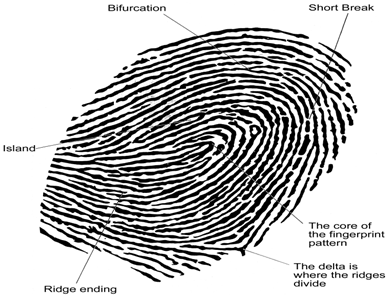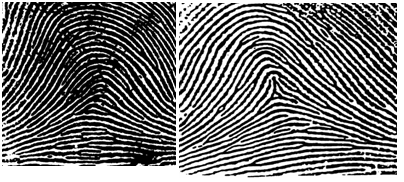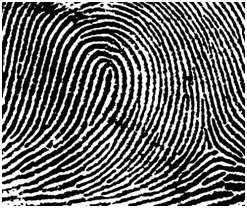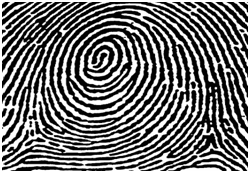Fingerprint identification is the method
of identification based on the different patterns of human fingers,
which is actually unique among each person. It is the most popular way
of acquiring details of any person and is the most easy and convenient
way of identifying a person. An advantage of fingerprint identification
method is that the fingerprints pattern remains same for a person
through out his/her life, making it an infallible method of human
identification. The study of fingerprint identification is Dactyloscopy.
Defining fingerprints:
The skin surface of any human finger
consists of a pattern of dark lines of ridges along with white lines or
valleys between them. The ridges’ structures changes at points known as
minutiae and can be either bifurcated or of short length or two ridges
can end on a single point. These details or patterns are unique in every
human being. The flow of this ridges, their features, the intricate
details of ridges and their sequence is what defines the information for
fingerprint identification.
Different ridge patterns are as given below:

Finger patterns can be divided into 3 groups as shown below
- Arches: Ridges enter and exit on same sides

- Loops: Ridges enter on one side and exit on different side
- Whorls: It consists of circles or mixture of pattern types.
Obtaining Finger prints:
There are two ways of obtaining latent prints or finger prints
- Using chemical methods: Spraying the surface with black powder can reveal the finger print patterns which can then be lifted using a clear tape. Different chemicals like cyanoacrylate (which can develop fingerprints on a variety of objects), Ninhydrin (which bonds with amino acids present in finger prints, producing a blue or purple colour) can be used. Also magnetic powder can be used to reveal finger prints and works on shiny surfaces or plastic bags or containers.
- Using Automatic Identification method: The fingerprint images can be acquired using different sensors. Examples are Capacitive sensors which obtain pixel value based on the capacitance of the fingerprint characteristics as each characteristic like a finger ridge has different capacitance, optical sensors which use prisms to detect change in reflectance of light by each characteristic and thermal scanners which measures the difference in temperature over time to create a digital image.
Finger print identification Process:
Basically digital imaging technology is used in acquiring, storing and analyzing the fingerprint data.
- Acquiring Images: As explained above, different sensors can be used to obtain finger print digital images. Basically the fingerprint scanner consists of a optical scanner or a capacitance scanner. The optical scanner consists of the charge coupled device which consists of light sensitive diodes which give electric signals when eliminated. The tiny dots representing the light that hit the spot are recorded as pixels and the array of pixels form the image. When we place our finger on a glass plate or monitor surface, the camera takes the picture by illuminating the ridges of the finger.
The left image given below shows the
whole structure of the fingerprint acquisition using optical scanner and
the right image is the real time example of the system.
Storing the images: The acquired image is then processed using digital image processing techniques as explained below:
- Image Segmentation: The acquired image tends to contain unwanted features along with the relevant features. To remove this, thresholding based on variance of each pixel in the image is done. The pixels having intensity (gray level value) greater than the threshold are considered where as the pixels having intensity lesser than the threshold are eliminated.
- Image Normalization: Each pixel in the image has different mean variance. Hence to obtain a uniform pattern, normalization is done, so that the image pixels are in a desired range of gray values.
- Image Orientation: It defines forming the image based on ridge orientation at each point. It is done by calculating the gradient of each pixel at x and y directions and then calculating the orientation by determining the average of vector orthogonal to the gradient.
- Constructing the frequency image: It is done to determine the local frequency (rate of occurrence) of ridges. It is done by projecting the gray values of each pixel along with the direction perpendicular to the ridge orientation and then calculating the number of pixels between consecutive minimums in the waveform, which correspond to the ridges. Another way is using Fourier transform technique.
- Image Filtering: It is done to remove unwanted noise. It is done either using a Gabor filter or a Butterworth filter. Basic way is convolving the image with the filter.
- Image Binarisation: The filtered image is then converted to binary image using thresholding technique, to improve the contrast. It is based on global thresholding, i.e. pixel value greater than the threshold is set to 1 and pixel value less than , is set to 0.
- Image thinning: It is done to eliminate foreground pixels until they are one pixel wide. It preserves the connectivity of the ridges.
Analyzing the Images:
It involves extracting the minutiae details from the processed image
and then comparing them with the already stored image patterns in the
data base. Minutiae extraction is done by calculating the crossing
number or the half of sum of differences between pair of pixels in a
eight connected neighborhood (eight connected means a pixel surrounded
by eight pixels). The cross number gives a unique identification for
each finger print characteristic.
The acquired image along with the
extracted details are then compared with the existing details in the
databases which can be tenprint or palm print records, for matching and
if images or the details match, the person is identified. The system provides
a list of the closest matching fingerprint images from the tenprint
database and the results are verified to determine if a identification
is made.
Advantages of Fingerprint Identification:
- It is highly accurate
- It is unique and can never be same for two persons.
- It is the most economical technique.
- It is easy to use
- Use of small storage space
Applications of Fingerprint Identification:
- To identify criminals in crime scenes. It was one of major reasons for development of this technology by FBI in USA.
- To identify members of an organization. It helps improves security such that only authenticated persons can enter the secured area and not any other members.
- In Grocery stores to automatically recognize and bill a registered user’s credit card or debit card.
Photos Credit:
- FingerPrint pattern by Emeraldandsight
- Plain Arch by Ridgeandfurrows
- Tented Arch by ridgeandfurrows
- Ulnar and Radial Loop by ridgeandfurrows
- Whorls by ridgeandfurrows
- Optical Fingerprint sensing by idteck
- Fingerprint identification scanner by wikimedia
So, this is the brief idea about Finger
Print Identification. Any further inputs like details about the
processing techniques or on the electrical and electronic projects are welcome to be discussed…








No comments:
Post a Comment